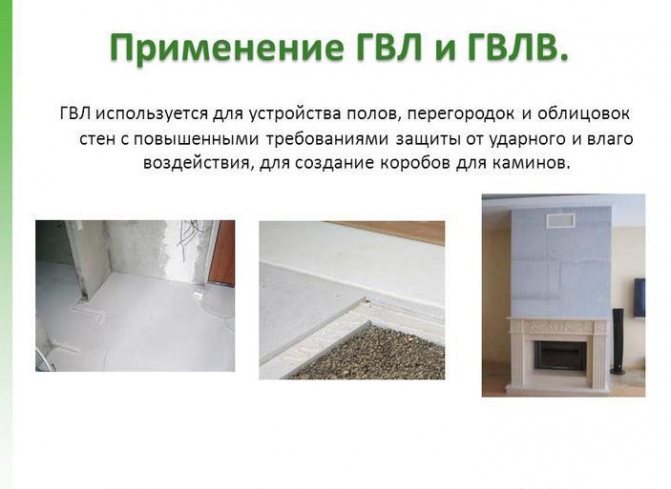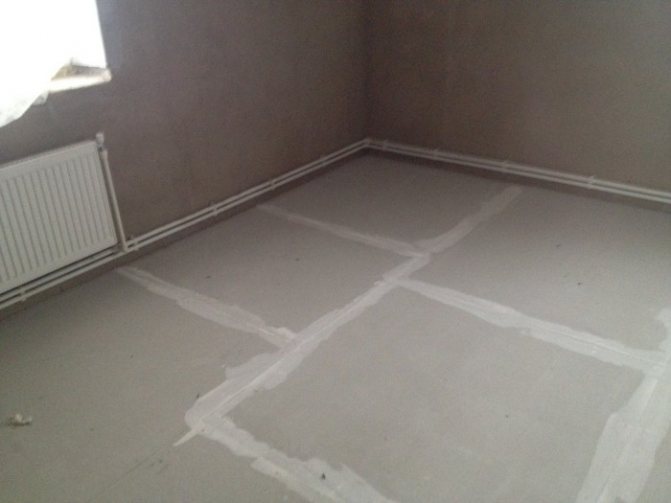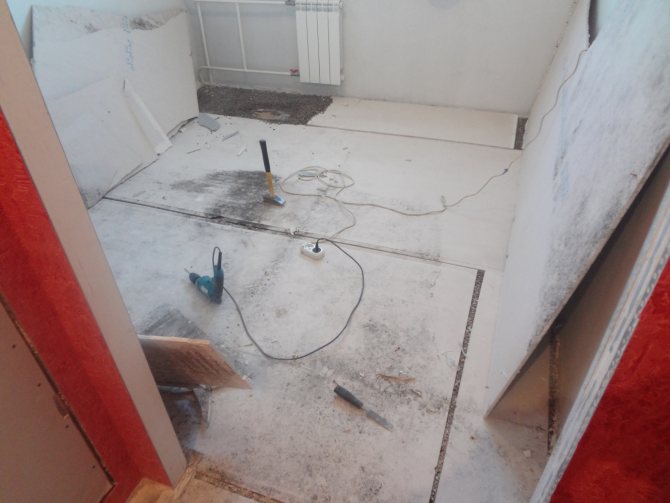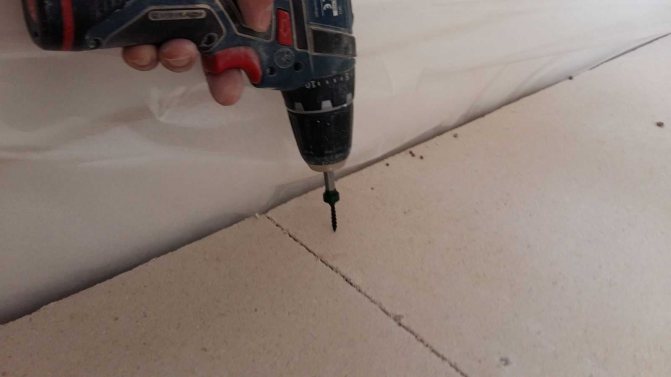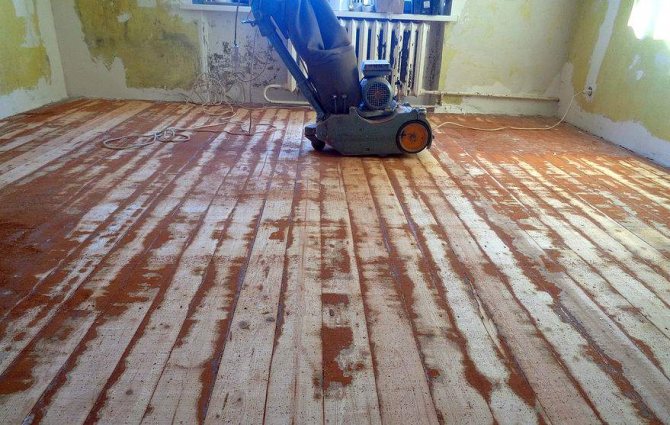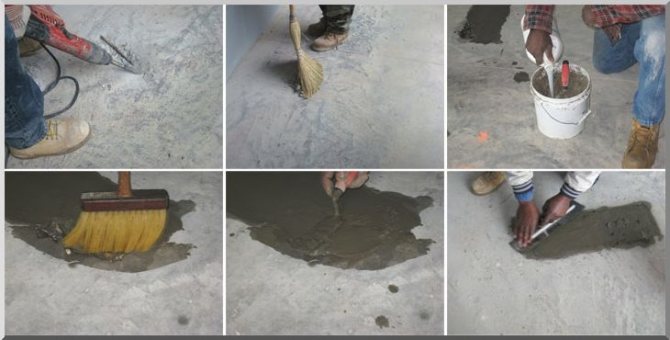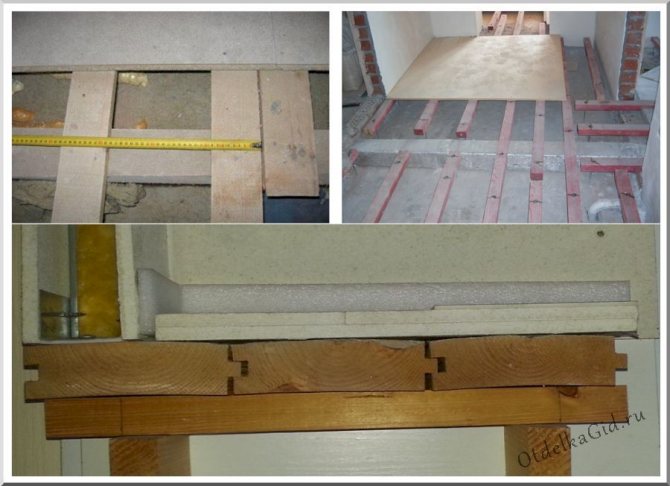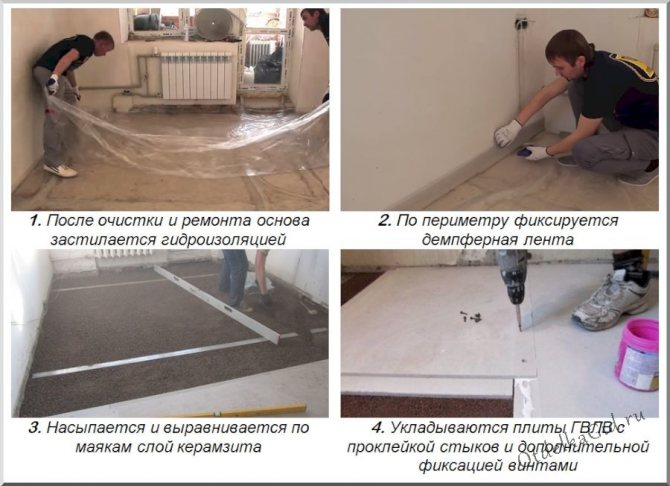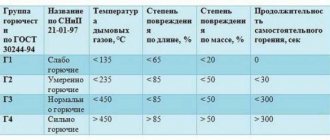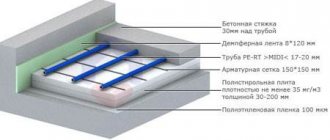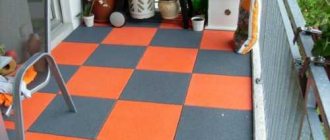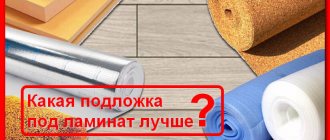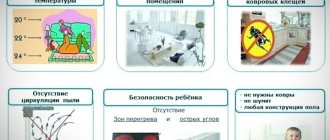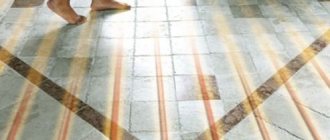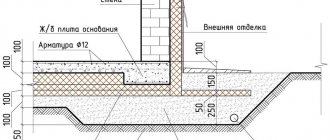Technology and nuances of laying GVL on the floor under the tiles
Gypsum fiber materials have proven to be excellent when performing work on horizontal substrates. Due to its stable characteristics, the resulting surface is suitable for cladding with various products. Most often, the installation of GVL on the floor under the tiles in the house is complemented by the installation of underfloor heating. But in order to obtain a quality result, certain rules must be taken into account.
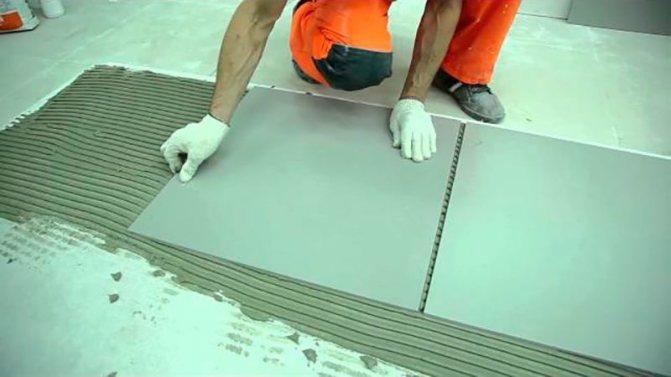
Characteristics and features of the material
Gypsum fiber panels have a lot of parameters that distinguish them favorably from other sheet products:
- Strength. The homogeneous structure ensures high performance. This is due to the composition: gypsum and cellulose fibers, which give a reinforcing effect.
- Viscosity. Elements can be processed in various ways: sawing, milling, etc., this will not lead to damage to the structure and deformation of parts. It is due to this that a good result is achieved when installing a warm floor.
- Fire safety. The products do not support the spread of fire, which allows the slabs to be laid on various communication systems.
- Low thermal conductivity. The resulting gypsum-fiber surface can be used as additional insulation. But this greatly complicates the process of installing a warm floor, since the system has to be literally built into the sheets of gypsum fiber board.
- Wide range of applications. The slabs are suitable for concrete and wood substrates as well as for dry screeds. The sheets have a relatively low weight, therefore they do not exert a significant load on the bases.... The material can be laid with your own hands without the involvement of specialists.
The most important advantages of this material are environmental friendliness and resistance to combustion.
Application area
The use of gypsum fiber sheets significantly increases the soundproofing characteristics of the floor. Another advantage of this finishing material is the ability to retain heat, therefore, GVL for the floor combines the functions of a subfloor and insulation. Using GVL sheets, you perform the screed in a dry and clean way and you can immediately start laying the topcoat.
Dimensions of GVL sheets
There is a moisture resistant version of this material - GVLV, and ordinary GVL sheets. They are used in different rooms.
Moisture-resistant sheets of gypsum fiber board are used in rooms with high humidity, and ordinary sheets are laid on the floor in residential and industrial premises, where there is no risk of leaks of water supply systems and high air humidity.
Application of gypsum fiber sheets
GVL has a wide range of applications in construction and reconstruction, and in ensuring the safety of technical and utility rooms. Sheets, in addition to their use for flooring, are used for wall partitions, ceiling cladding.
Living and plumbing rooms, utility pantries and attics, attics and basements. The main condition is humidity not higher than 70%.
Resistance to open fire makes GVL indispensable in the equipment of elevator shafts, moisture resistance - in the equipment of bathrooms and garages, durability - in the equipment of gyms and courts.
Installation features
Components of a gypsum fiber screed
Before proceeding with the collection of dry screed from GVL sheets, a layer of waterproofing material is laid on a wooden or reinforced concrete base. For this purpose, expanded clay is most often used, since it levels and insulates the floor well.However, the very first layer that you put directly on the surface of the floors should be polyethylene with a thickness of 200 microns or more. On some floors, you can lay glassine or roofing paper. This very first layer will take over the vapor barrier function.
Expanded clay is poured onto the waterproofing film
A layer of expanded clay with a thickness of at least 10 cm is poured over the rough screed
Video - What kind of backfill to choose for a dry floor screed
As additional layers between expanded clay and GVL sheets, you can put polystyrene foam plates. This technique guarantees increased heat and sound insulation and can be used, for example, in children's rooms. So you can get rid of neighbors' frustrations about your child's noisy games. Also, any engineering communications can be laid under the GVL sheets. Between the GVL sheets and the topcoat, you can mount a water or electric underfloor heating. This feature can come in handy when arranging a bedroom, nursery, kitchen, bathroom and hallway, in a word - in any room where additional heating of the floor and air in the room may be needed.
Communications are laid under the waterproofing film
Installation of a base floor made of gypsum-fiber boards of medium size, approximately 1.5 mx 1 m, with a thickness of 1 cm to 1.2 cm, is quite quick and easy, since it is based on the principle of "dry operations". The fastest floor installation is carried out using factory-glued double sheets with folded ends. If for some reason you cannot purchase double GVL plates, then simply lay the sheets in two layers. The second method, of course, is less convenient, but it allows you to get out of the position and get a perfectly flat base floor.
Options for laying GVL on the floor
Laying sheets of gypsum fiber board on the floor
Laying GVL floor elements
The joints between the floor elements are putty
The standard length of GVL sheet is 2.5 m, and the width is 1.2 m. The most common thickness is about 10 mm. In order to avoid chalking, each sheet is impregnated with a water repellant and a specialized composition that prevents this phenomenon and acts as a primer. Each slab has one side carefully sanded.
Features of installing a warm floor on GVL
Heating systems can be laid on gypsum fiber boards, but it is necessary to have an idea of some of the nuances of such work. If one layer of gypsum fiber is used, then special grooves must be made on the surface of the plates for the underfloor heating cable. In this case, do not forget to be sure to prime the GVL sheets.
Important! You should not lay the underfloor heating cable under the GVL, since its plates have thermal insulation properties.
If you are laying two or three layers of gypsum fiber, then the top layer of the material must be assembled from strips, the width of which corresponds to the cable installation step. In this case, it is necessary to provide for a gap for laying the cable, then the grooves should be covered with tile glue.
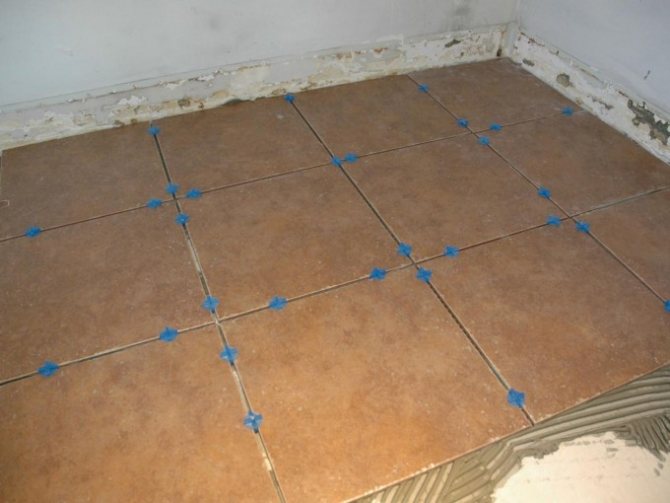

Not every home craftsman can independently install a warm floor system, so it is advisable in this case to invite professionals for installation.
After completing all the work on laying gypsum fiber boards, and after waiting a day, you can proceed to the finishing of the floor. Do not forget that you can lay any floor covering on the GVL, depending on your preferences. And the dry method of laying allows you to significantly save time for repairs, as well as money, because a high-quality cement-sand screed is expensive. Thus, gypsum fiber sheets are a convenient, economical and fast way of arranging a floor, which has excellent performance characteristics.
Other important characteristics of moisture resistant and conventional gypsum fiber sheets
| N / a | Name of characteristic GVLV and GVL | Value | unit of measurement |
| 1 | Humidity | less than 1.0 | % |
| 2 | Density | no more than 1200 | kg / m3 |
| 3 | Flexural strength | more than 5.5 | MPa |
| 4 | Hardness | more than 22 | MPa |
| 5 | Thermal conductivity | 0,22−0,35 | W / m * ºС |
What are the consequences of errors in the installation of gypsum board
It is important to strictly follow the installation rules. If you do not cut the folded edge of the sheets that will be located near the walls, then there is a high probability of the floor sinking in this place. Metal beacons left in the dry screed layer can lead to the fact that when expanded clay shrinks, deformation of the floor will occur. Be sure to use only dry expanded clay or dry it thoroughly, otherwise the floor is guaranteed to deform and you will have to invest your time and money in repairs again.
Video - Knauf dry floor screed with additional heat and sound insulation
Advantages and disadvantages of GVL boards
Among the advantages of GVL boards over other materials include the following parameters:
- resistance to moisture - in this parameter, GVL is superior to drywall and fiberboard;
- massiveness;
- high density;
- flexibility;
- environmental friendliness;
- thermal insulation;
- soundproofing;
- combustion resistance (confirmed by a corresponding certificate);
- GVL does not deform under the influence of temperature;
- easy installation;
- minimum amount of waste.
The disadvantages of GVL boards are as follows:
- the plates are heavy enough;
- it is important to follow the rules of installation and storage, in case of violations, an increase in fragility is possible;
- slabs are more expensive than drywall.
As you can see, this material has many more advantages than disadvantages.
Advantages and disadvantages
The material is in demand due to the mass of its advantages:
- Environmental friendliness;
- Ease of installation;
- Density;
- Resistant to combustion.
Working with sheets is very simple. In the process of work, you do not need special skills or a specific tool. Therefore, the installation does not take much time, moreover, in this way you can save a little without calling specialists. When working with sheets, there will be little debris, there is no need for thorough cleaning after their installation.
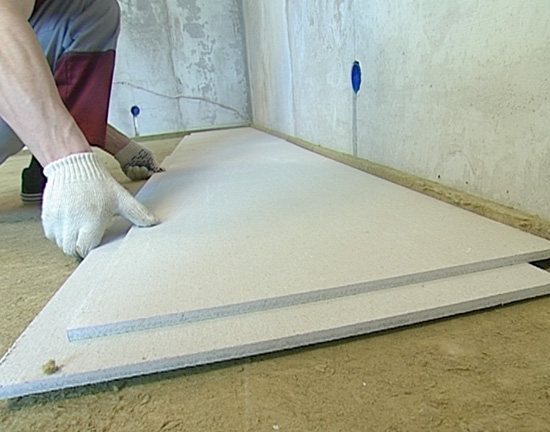

GVL slabs are used as a substrate, insulation or subfloor. Almost all types of cladding can be laid on such a base without additional costs, because the sheets provide a perfectly flat surface.
The sheets differ in density, but it will not be possible to bend them, unlike the gypsum board sheets. Therefore, they are not used for finishing. The sheets are not afraid of water. Even standard boards are able to withstand the effects of moderate indoor humidity. The sheets are absolutely safe. They contain no toxic substances, so you can even put them in a nursery.
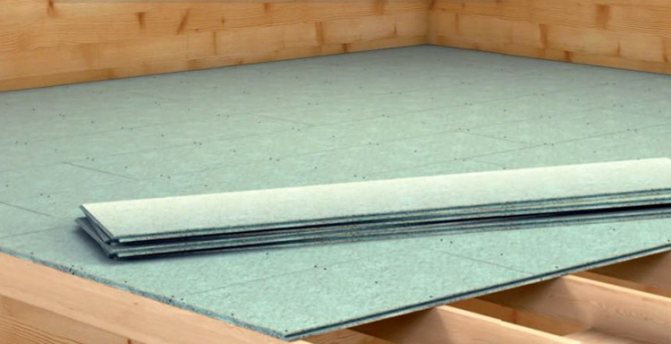

The soundproofing characteristics of the material remain at their height; it can be used not only as a substrate, but also to create interior partitions. After installation, there is no need to wait until the material is dry, you can immediately start facing. When burning, the material does not support it, acting as a protective layer. In addition, the material not only does not release heat, but is also able to retain it.
Sheets always stay warm, so they are ideal for unheated rooms. They can also be installed under the "warm floor" system.
The disadvantages of the material are recognized in comparison with the sheets of gypsum board. First of all, it is the price. The cost is not so high, but when compared with GKL sheets, the price will be about twice as high, so not everyone can afford them. Despite the light weight of the material, it is still much larger than GCR sheets.
Step-by-step instructions for installing GVL floor
Step 1
Before starting the installation of the GVL floor, you should dismantle the old floor covering, boards, fiberboard sheets and logs on which the old floor lay. We remove absolutely all old materials, as a result, bare floors should remain.Be sure to thoroughly sweep the surface, remove all construction debris and, if possible, dust.
Step 2
Cleared of old materials and debris, floors may have cracks and holes. They should be eliminated by pouring inside a fast-setting cement mortar with a marking of at least 150 or covering it with an assembly mixture. Alabaster is also suitable for this purpose.
Step 3
You will need a laser level for marking
It is necessary to mark the top level of the backfill. For this stage of work, you will need a laser or water level. The height of the marks can vary from 2 to 6 cm. This range depends on the unevenness of the floors. As a result, the base floor will be located 2 cm higher, since the thickness of the double sheet of gypsum fiber board will be added.
Step 4
The slabs are completely ready for waterproofing. The entire surface should be covered with plastic wrap, if the floors are concrete, and glassine and bituminous paper can be laid on a wooden surface. The sheets of waterproofing material should overlap, overlapping each other by 20-25 cm. The edges should be glued with mounting tape.
The film should go over the walls and its edge should be at least 2 cm above the marks applied on the level. Adhere the waterproofing to the walls with mounting tape.
Step 5
If the floor of the GVL floor will be located communications, then all the wires must be carefully hidden in a protective corrugation and fixed on the floor. It is important to take into account that between the corrugation with wires and GVL plates there must be a layer of expanded clay no thinner than 2 cm. If necessary, correct the height of the marks.
Step 6
To exclude the appearance of the so-called sound bridges, there are two options for working. You can glue the perimeter of the room with a 10 cm wide and 1 cm thick foam rubber edge tape.
You can also use mineral wool or polyethylene foam edging tape for sound insulation. These materials perfectly fulfill the function of protecting the finished floor from deformations that can be caused by thermal expansion.
After the installation of the soundproofing tape is completed, it is necessary to cut off the excess, focusing on the upper floor, including the backfill level and the thickness of the gypsum board.
Step 7
We start backfilling expanded clay. Carefully sprinkle expanded clay with a fraction of no more than 0.5 cm on the vapor barrier layer. Be sure to put on a respirator, since when expanded clay is poured out of the bags, a large amount of dust will inevitably rise into the air.
Step 8
The next step is to level the expanded clay using metal profile guide beacons. Be sure to use a level when performing this operation. If you are using a water level, then when calculating the distance between the profile, be guided by the length of the level. The ends of the tool should lie on adjacent guides, which will subsequently serve as a guide and support for the rule. Some craftsmen find it convenient to use a water level instead of a rule. This technique gives additional control over the thickness of the expanded clay layer. Level the backfill meter by meter.
Pay particular attention to compacting material near walls, doorways and corners of rooms. Perform this work only in a respirator to prevent dust from entering the respiratory tract.
Leveling dry backfill
After completing this stage of work, be sure to remove the guides, and fill the resulting voids with expanded clay. In order not to deform the leveled and rammed expanded clay, use sheets of gypsum fiber board as special "islands". However, any similar materials are suitable for this purpose. For example, waste fiberboard or plywood. The size of the islands must be at least 50x50 cm.
Step 9
Additionally, the floor can be insulated and soundproofed, for this, sheets of drywall and foam are laid under the gypsum fiber board
Additionally, the floor can be insulated and soundproofed, for this, sheets of drywall and foam are laid under the gypsum fiber board
Laying starts from the far corner of the room
Joints are glued during installation
Laying GVL sheets
The installation of gypsum board should be started from the corner located farthest from the door. This will eliminate the possibility of damage to the leveled dry expanded clay screed. The edge of the sheet, located against the wall, must abut against the edging tape. The seam edges of adjacent slabs must be coated with PVA glue to obtain a strong "lock". Then, every 10-15 cm, it is necessary to screw in self-tapping screws with a length of at least 2 cm. Thus, the perimeter of each sheet will be strengthened in two ways.
When laying the second row of gypsum fiber board, shift the joints so as to obtain the effect of brickwork. Use a jigsaw to adjust the slabs to size.
In cases where there is a very uneven floor base in the room and the thickness of the expanded clay layer is from 6 to 10 cm, it is necessary to lay the second one on top of the first layer of gypsum fiber board. When laying the second layer, work should be started from the corner opposite to the entrance to the room. Carefully make sure that the seams between the slabs of the first and second layers do not overlap or overlap.
Finished work. Smooth and durable floor
Step 10
When the laying of the GVL floor is completed, you need to putty the seams between the sheets and those places where the screws are screwed. Additionally, you can use a reinforcing tape. When laying gypsum fiber board floors in the bathroom and in the kitchen, it is worth using special means for waterproofing joints with walls and seams between sheets.
You can start laying the final floor covering one day after the end of work with gypsum fiber boards, during which time the glue and putty will have time to dry. On top, you can put tiles, laminate, linoleum or any other covering. Use a specialized underlay if necessary.
Laminate can be laid immediately on the GVL floor
Video - GVL for floor
Installation of GVL on a wooden floor
With a wooden floor, things are a little more complicated. The base coat must be carefully prepared. The first step is to remove the old coating and carefully examine everything. If there are any affected areas, they must be replaced and an antiseptic applied. Then, if necessary, mount additional logs, check with a spirit level (who does not know, this is the name of the tool for checking the horizontal position of a line on a plane), if necessary, align. The next moment we screw the protruding screws deeper, we carry out the processing with a plane, we putty the flaws.
Now you need to do everything right. In order not to damage the sheets of gypsum fiber board, cut them strictly in the supine position. A hacksaw or cutter is suitable for this. First, the edge tape is fixed along the entire length of the room, then a vapor barrier is placed. To avoid any gaps and gaps, the strips of material are overlapped. Then a leveling layer of expanded clay is poured. The base must be leveled using a rule or building level and tamped. All attention to the places near the walls and in the corners.
The initial layer of gypsum fiber board is mounted, starting from the corner at the doors. When laying the entire layer, the plane is covered with glue, then the second layer is laid, starting from the other side. According to the rules of laying, glue is applied to the folds, and the plates are pulled together with self-tapping screws. At the end, putty is applied to the right places, and then the surface is primed. When the height of the expanded clay layer exceeds 10 cm, then an auxiliary GVL layer is required.
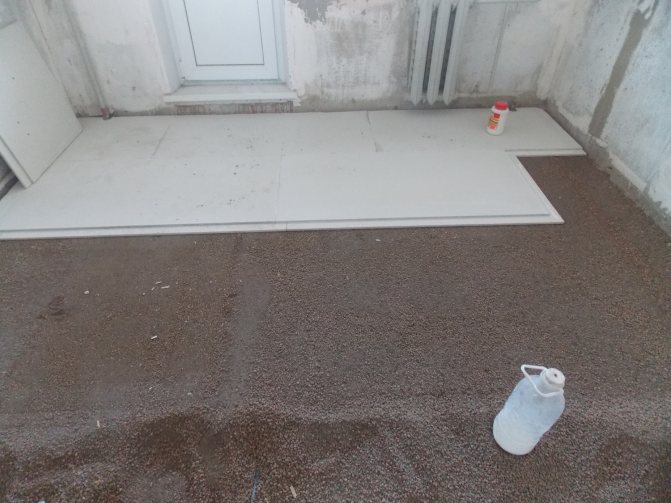

It is necessary to lay GVL plates from the corner of the doors
Installation of GVL floors, technology features
The rapidity of progress affects all areas of life, but it is especially noticeable in the construction market.Not even a month goes by here without the emergence of innovations. The innovations have significantly changed and simplified the technological processes of all stages of construction, making life easier for both professionals and beginners. Thanks to the use of advanced technologies, labor-intensive processes in the construction, reconstruction and repair of buildings, such as brickwork or concrete flooring, are replaced by new, simpler ones. An excellent way to make a high-quality and quick floor covering is to make a dry screed from GVL sheets. The work is carried out in comfortable conditions, without dirt and dust, with minimal labor costs.
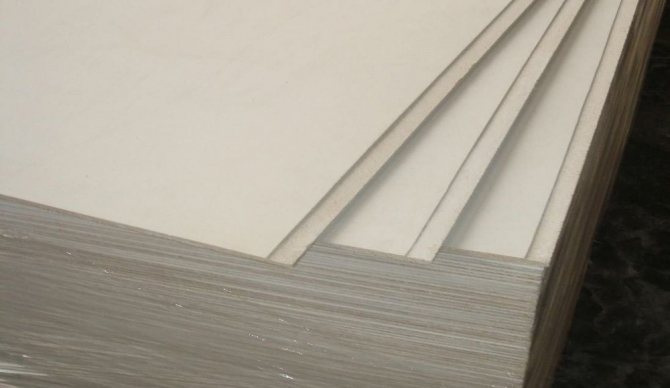

GVL - getting to know the material
The usual drywall on large construction sites and when carrying out local repairs is increasingly replacing the new generation sheet material - GVL (gypsum fiber sheet). It is a polished slabs made of ordinary gypsum, but reinforced with reinforcement. For this purpose, fluff pulp is used - a product of waste paper processing. In the process of manufacturing, plates with the GVLV marking are impregnated with hydrophobic compounds. The peculiarity of gypsum fiber sheets, which favorably distinguishes them from drywall, is the absence of a cardboard shell, uniformity of the structure, which gives the material high strength characteristics. The technology, by its principle, is very similar to the Knauf dry screed.
Laying GVL on wooden logs
In principle, everything has already been said above. If the wooden floor is flat, you can lay GVL without fear. It allows moisture to pass through normally, so that the wood is not threatened with decay. If the floor is uneven (which usually happens), it is best to dismantle it and lay the GVL along the logs. Or make a rough floor. If this is not possible for some reason, GVL can also be placed on a wooden floor. There is a possibility - eliminate irregularities with a plane, putty the cracks. If it doesn't work, there is an emergency option.
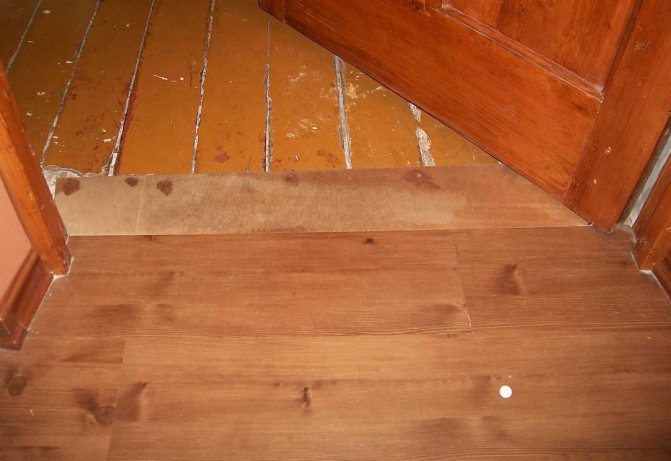

A gypsum fiber sheet will help align this.
We take a primer for gypsum mixtures, cover the floor in several layers. Pass all cracks with construction foam with good adhesion, level with the surrounding floor level. We dilute good quality gypsum plaster as for plaster (thick dough). We take a wide trowel and level the floor - apply plaster.
Rigid gypsum fiber sheets are ideal for leveling wood floors.
Before starting work, we check the condition of the wooden structures.
If necessary, we replace the elements damaged by rot, add lags.
We check the horizontality of the floors with a building level. We correct the deviation by placing wedges or removing irregularities with a plane.
We treat all wooden structures with antiseptic compounds.
We install a vapor barrier made of waxed paper or glassine.
To prevent deformations around the perimeter, we attach a damper tape.
We lay the thermal insulation of mineral wool, laid tightly between the logs or fill in the dry mixture of expanded clay.
We lay the gypsum-fiber sheets on the logs.


Figure 12. Laying GVL on wooden joists.
We glue the sheets together along the folds and fix them with self-tapping screws.
It is better to lay the second layer of gypsum board perpendicular to the first one, on glue.
We glue the top layer along the folds and fasten it with self-tapping screws, embedding the caps in the sheets.
https://www.youtube.com/watch?v=BRgKJAr40hc
We seal the seams and caps of the screws with putty, getting a hard monolithic coating, ready for finishing.
Gypsum fiber for the floor: pros and cons
Gypsum fiber sheets are used for cladding any surfaces in apartments, private houses, public buildings. With the help of GVL, walls and ceilings are decorated quickly and conveniently. They are much better suited for sub-flooring than drywall or fiberboard. Gypsum plasterboards with moisture resistant properties declared by the manufacturer, when water hits their surface, quickly collapse and warp.In addition, GCR is quite fragile, with strong point impacts, it may split.
Gypsum-fiber boards behave in a completely different way in similar conditions. They differ:
- refractoriness - gypsum does not burn, the maximum harm that fire can inflict on it, charring of the surface;
- durability - the reinforcement gives the brittle gypsum a hardness sufficient for the use of gypsum fiber board as a floor covering;
- moisture resistance - water does not penetrate into the pores of GVLV (moisture resistant) boards due to the treatment with hydrophobizing impregnation;
- low thermal conductivity - this indicator makes GVL sheets an ideal material for laying on the floor, they perform the function of insulation;
- resistance to low temperatures - unlike drywall, which can endure only four cycles of freezing and defrosting, GVL can withstand as many as 15 such cycles.
A small fly in the ointment in a huge barrel of honey - the cost of the material is quite high compared to drywall, however, it is justified by its merits.
Choosing high-quality gypsum fiber sheets for the floor
How to choose the right GVL for a particular room? First of all, they pay attention to the price and the manufacturer. Well-known companies keep their brands and do not produce obviously low-quality products. Low cost signals low quality due to the use of low-quality components or marriage in the production process. By trying to save on material, you can lose much more time and money later when defective plates fail before the stated service life.
When installing floors in rooms with high humidity - kitchens, bathrooms, baths, saunas, special moisture-resistant GVLV boards are chosen. For other rooms, ordinary gypsum fiber sheets are sufficient. Between single-layer gypsum fiber board of standard or small-format sizes and sheets consisting of two layers, the latter are more often chosen for flooring. They are made of two slabs glued together with an offset and forming a locking system. Such material is especially easy to install. It is from it that the so-called "dry" screed is usually performed.
How many layers of gypsum fiber board should be laid?
Usually one layer of gypsum fiber boards is sufficient. But if you want to lay two layers, then remember that they must be laid perpendicular to the elements of the previous layer. If a layer of expanded clay reaches a thickness of 10 centimeters or more, then GVL is laid in three layers. In this case, a foam layer can additionally be applied. At the same time, do not forget to shift the joints of adjacent rows, which are also fixed with screws and glue.
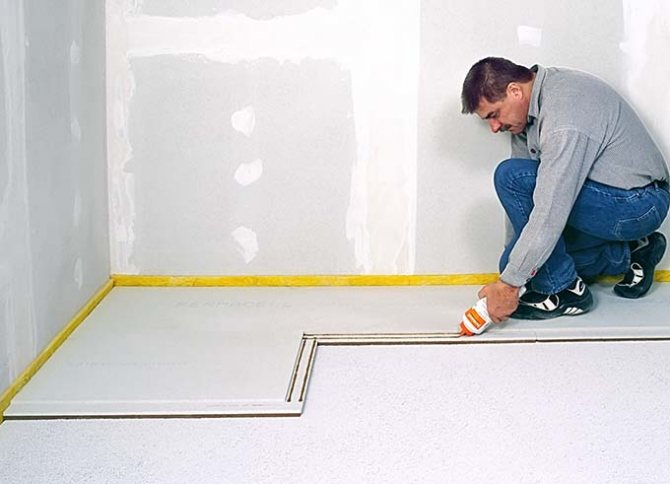

You can also buy double thickness sheets that are already glued. They are laid according to the same principle as for small-sized GVL boards. And the presence of special folds with an adhesive allows you to quickly lay a new coating.
Note! If you use gypsum fiber boards in rooms with high humidity, then additional waterproofing should be done in the area of joints and walls.
Benefits of dry screed
Although the concrete coating is one of the most reliable, any master, having once laid a floor from gypsum fiber board sheets, is unlikely to want to mess with concrete mortar for the monolith next time. Moreover, gypsum fiber has a high hardness and is perfect for sub-flooring. They do not sag or creak, they are suitable for laying any floor covering.
Installation of gypsum fiber sheets is a pleasure, especially for professional builders. Amateurs who get down to business for the first time also easily cope with this non-dusty job.
The material is easy to cut, thanks to its low weight, it is easy to fit.Utilities are placed under the floors made by dry method, cable mats are laid for the installation of the "warm floor" system.
Base for dry screed
The basis for laying GVL sheets is both a concrete coating and a wooden floor. Before starting installation, standard preparation of the base is required:
- concrete screed - the surface is leveled, the cracks are filled with mortar, if necessary, coarse grinding is performed;
- lean concrete is a cheaper base option;
- wooden floor - the broken logs are being repaired, the gaps between the floorboards are sealed with a special putty.
When installing floors, special attention is paid to the horizontalness of the surface. At all stages of work, from leveling the base to the device of the finished floor, control is carried out using a building level or level.
Scope of use of gypsum fiber sheets
The sub floor for arranging a dry screed made of gypsum fiber board can be either wood or concrete. The differences in the styling technique are quite insignificant. If necessary, the already quite good parameters of noise and thermal insulation can be improved by laying additional materials, for example, with expanded polystyrene sheets. The main thing is to take into account the thickness of all materials used so as not to "steal" the height from the room. In private houses with high ceilings, this indicator is usually not even looked at.
The high density of the material allows you to equip a "warm floor" system on its surface. However, do not use thick sheets, a thickness of 1-1.5 cm will be just right. In addition to this, professional builders even manage to lay engineering communications in a dry screed, without fear of damaging them with thick and heavy material.
GVL installation: 7 easy steps
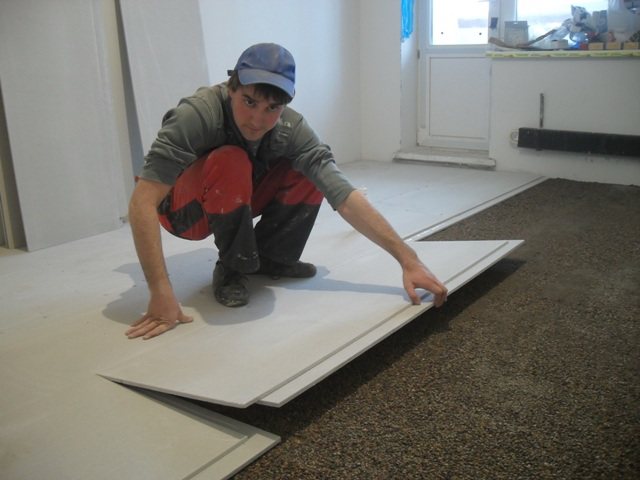

Installation of sheets of GVL
- The finished base is covered with waterproofing material... For the concrete screed, a polyethylene film with a thickness of 0.2 mm is used. Glassine is laid on wooden floors. The edges of the waterproofing are placed with an approach to the walls, the joints are sealed with construction tape.
- Edge tape is glued along the perimeter of the walls - a strip of polystyrene 10 cm wide, 1 cm thick. This measure helps to prevent swelling and cracking of the gypsum fiber board.
- The entire surface of the base is covered with amorphous insulation to a thickness of at least 2 cm - expanded clay, perlite or coarse river sand. Carry out leveling it with a building rule. To make it possible to move around the lined insulation without fear of damaging the horizontality of the bedding, several "islands" are arranged.
- From the wall opposite the door, begin the installation of the first layer of gypsum fiber boards... The folds are processed with PVA glue, in addition, the material is fastened with self-tapping screws in increments of 20-30 cm, depending on its size.
- The entire surface of the mounted sheets is treated with glue, the next layer is laid on them... Laying the second layer must be done in the opposite direction to the first, so that the material is staggered.
- Putty is used to seal the joints between the slabs, as well as the place of installation of self-tapping screws. Cut off the protruding part of the edging tape and waterproofing material.
- Lay the finishing floor - wooden boards, parquet, tiles, laminate, linoleum, PVC tiles. The coating is ready for use immediately after installation.
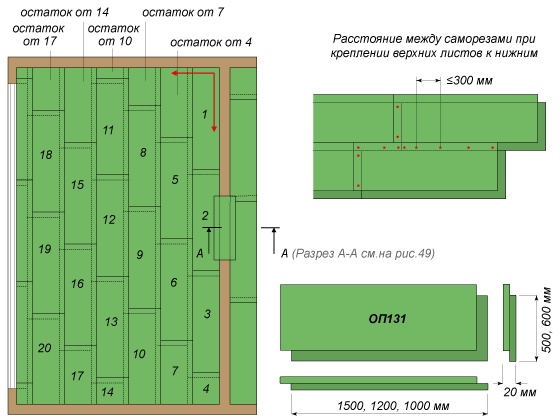

An example of the correct placement of sheets
The main mistakes when installing a floor from gypsum fiber board
GVL is a high-quality and durable material, but mistakes during its installation can lead to unevenness and defects in the floor. When working with gypsum fiber, be sure to:
- cut the sheets with a construction knife on a hard plane in order to avoid getting a low-quality edge that requires re-cutting;
- cut off the folded edge of the sheets laid against the walls in order to prevent them from sagging during operation;
- use only dry amorphous insulation - gypsum fiber will necessarily absorb moisture from expanded clay, this will lead to its deformation;
- dismantle the metal profile used for filling expanded clay - the insulation shrinks during operation, the geometry of the floor is disturbed;
- grease the folds with glue with good quality - poorly glued plates are not monolithic enough and make a ringing sound when walking;
- screw the self-tapping screws to a depth of at least 1 mm - an incompletely screwed fastener raises the top layer, creating bumps on the floor.
The use of high-quality materials, installation carried out in accordance with all the rules is a guarantee of the reliability and durability of the floor covering.
Video review of GVL flooring technology
Installation of "dry" floors using gypsum plasterboard
The screed is the main type of floor preparation, providing leveling, the necessary rigidity, insulation, sound insulation.
A screed from a cement-sand mixture is always associated with dirt, a large amount of manual work and the need to wait until the mortar used is completely dry.
And if the screed is in two layers, the waiting period is doubled. When completed, it takes over 25% of the load-bearing capacity of the overlap. In addition, you will need the cost of additional materials for waterproofing the floor, ensuring viscosity, etc.
Dry screed based on gypsum fiber board has received indisputable recognition in construction.
It is irreplaceable in the device:
- base floor on expanded clay bedding 2 cm with sufficient insulation;
- subfloor, using insulation, up to 3cm - for leveling and insulation;
- prefabricated screed with additional insulation to expanded clay in the form of expanded polystyrene plates - with serious irregularities in the floor and increased requirements for its insulation.
The dry screed allows you to go straight to the installation of the main floor covering.
The technical characteristics of GVL allow, at the same time, the use of glue, mastic, which do not contradict the chemical properties of the sheet.
Floor installation technology using gypsum fiber sheets
- Surface preparation
If you are laying on wooden floors, reinforce the movable floorboards, exclude the causes of squeak;
It is enough to clear the concrete floor of debris;
How to lay GVL sheets on the floor?
- Lay 10x10 mm mounting tape (made of foam, isolon or basalt wool) around the perimeter of the room for sound and noise absorption and in case of deformation due to temperature fluctuations;
- Spread an overlap over the entire surface of the floor with a polyethylene film for the device of the vapor barrier of the floor;
- Fasten guides made of an aluminum profile or logs made of wood, which will contribute to the uniform distribution of expanded clay and in the future will serve for fixing the gypsum fiber board;
- Backfill the floor with expanded clay
Take slag pumice, expanded clay sand or Compavita and level it with a level.
Foam or fiber insulation can be used.
At the time of this operation, installation work on the wiring of communications under the floor or the installation of a warm floor system is possible.
- First layer
For this layer, you will need small-format gypsum-fiber sheets. They are laid along the length of the room, from the corner closest to the door (if the insulation is bulk) and from the opposite wall (with other types of insulation).
The sheets are fastened with self-tapping screws (screw length = sheet thickness) "flush". Trimming with a hacksaw or jigsaw is done at the end of the row.
The next rows are laid, shifted by 30-40 cm. If the mounting tape protrudes above the sheet level, it is cut off. The adhesive connection of sheets to each other allows seams of no more than 2 mm, the glue squeezed out by compression is removed.
- Second layer
This layer of standard gypsum fiber board is laid on the surface of the first treated with adhesive mastic or PVA-glue, across the laying - the sheets of the first and second layers are located relative to each other at right angles;
It is possible to immediately use a two-layer coating of factory gluing; if the edges of the sheets have folds, the assembly is carried out as with the technology of laying the laminate;
If a third layer is also installed, it is made up of standard size sheets with an additional layer of foam.
The thickness of this layer should correspond to the sum of the values of the thickness of the lower layers.
- In conclusion
The self-tapping heads and seams are putty, the entire surface is primed to create a flawlessly even base and the front floor, carpet, laminate, linoleum, parquet, porcelain stoneware or tiles are laid.
How to make gypsum fiber floors. Dry screed from gypsum fiber board.
A screed made of gypsum fiber sheets (GVL) is a proven technology for creating a leveling layer for floors. The base made of gypsum fiber board is durable, reliable, suitable for any floor covering - you can lay laminate, linoleum, carpet, ceramics, etc. Creating floors from gypsum fiber sheets is much less laborious than laying the screed with a wet method.
What are gypsum fiber sheets
Gypsum fiber sheets are made from a mixture of gypsum and cellulose wool with various additives. Cellulose filaments inside the sheet reinforce the material, give it elasticity, eliminating the excessive brittleness of the gypsum. As a result, sheets of gypsum plasterboard, in comparison with gypsum crate, are much more bending and tough, the material is supplied without a shell and does not crumble. The volumetric weight is 1.25 T / m3, which is more than that of drywall. But this is 2 times less than that of a cement-sand screed - 2.5 T / m3.
GVL sheets of various sizes are available. Standard - 1500x1200 mm - the same as for drywall, but with a thickness of 10 mm. But there can be small-format sheets -1000x1200mm, or other sizes of plates for various purposes. For example, Knauf produces the so-called prefabricated floor made of gypsum fiber board - slabs of reduced size, but much thicker, weighing up to 18 kg in the expectation that one worker can lay the material.
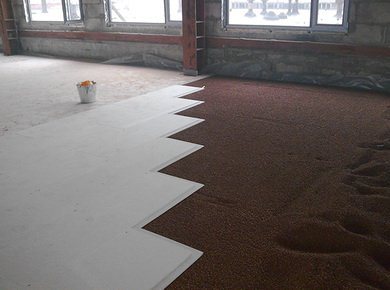

GVL sheets can be with a regular straight edge or with a seam. Special sheets for creating floors are made with a wide rebate up to 10 cm, which allows them to be fastened between in one surface using PVA glue and screws.
Usually dry screeds lying on a continuous bedding or an elastic layer of insulation (mineral wool, expanded polystyrene) are created with a thickness of 2 cm or more.That is, two or three layers of gypsum fiber board are laid with the obligatory displacement of the seams between the layers.
The use of GVL in one layer is allowed provided that the bedding is accurately leveled and rammed, and a material with its own significant elastic resistance to bending is used as a floor covering - laminate, boardwalk, parquet, parquet board.
Distinctive features of GVL floors
From the point of view of the consumer, the base created with the help of gypsum fiber board laid on a layer of insulation or just sand filling is not much different from a concrete screed. It is firm and even, suitable for laying any type of flooring.
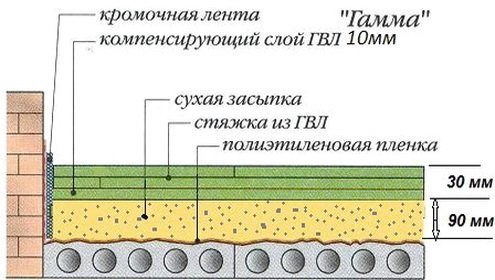

But the very arrangement of the floors is carried out without wet processes - cheaper and faster. In addition, the possibility of laying GVL up to 30 mm thick saves internal space, compared to a cement-baked screed on a layer of insulation. And also the weight of the screed made of gypsum fiber board can be several times less than the cement-sand one, which is important for apartments when creating floors on the ceiling.
In addition, there are advantages to the manufacturing process itself in creating the sub-floor.
- GVL screed is created faster, less labor costs.
No curing time is required - the screed is ready for use at the time of creation.
Dismantling the structure is much easier compared to concrete options.
- GVL is a very moisture-consuming material, acts as a moisture stabilizer in a house or apartment, which affects comfort for the better.
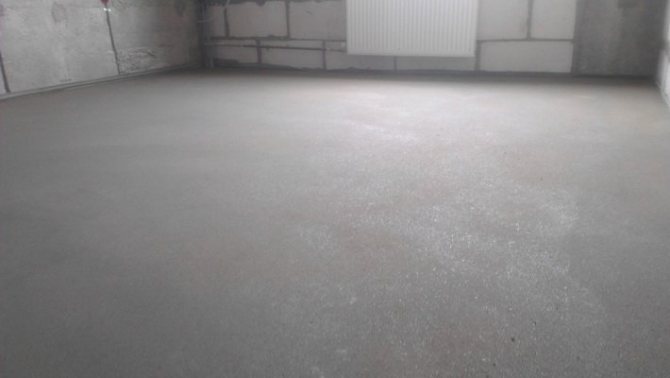

The coating is afraid of water
But it is possible to use GVL only under the condition of the most reliable vapor barrier from a source of moisture.Gypsum can easily be saturated with water, while softening and increasing in volume, bending. So a wet base may swell. Therefore, usually GVL is not risked to be used in showers, swimming pools, bathrooms - where moisture can penetrate from the side of the room, even with complete waterproofing.
The same is true over the underground in the house - with poor ventilation and a violation of the vapor barrier, the gypsum can moisten to the state of moist soil under the house and problems begin. GVL is not used, like drywall, in basements, boilers, in some industrial premises ...
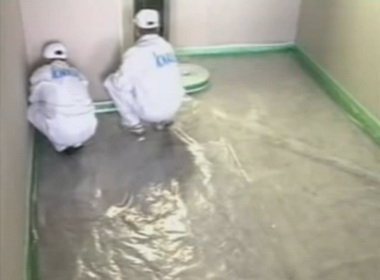

Even when laying on concrete slabs, for gypsum plasterboard, it is recommended to introduce a vapor barrier layer into the floor structure under the insulation and gypsum fiber board. And in the apartments there is also a layer of waterproofing on top of the GVL for protection in case of flooding ...
Sequence of creating floor and covering
The concrete base is covered with a layer of vapor barrier - polyethylene with a thickness of at least 0.2 mm, while the overlap of the film strips should not be less than 200 mm, and it is also wrapped on the walls above the level of the finished floor.
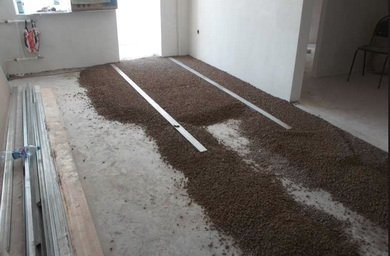

A damper tape or expanded polystyrene with a thickness of 1 cm above the level of the finished floor is placed along the walls. The goal is to create an expansion gap for thermal expansion between the floating base and the walls, to reduce impact noise transmitted to the walls.
The next stage in creating a floor from gypsum fiber board is a leveling bedding. In the future, it should not sink, thicken, i.e. there should be no precedent for the sagging of the gypsum floor. It is recommended to use fine-grained expanded clay with a layer of up to 100 mm. If the layer is larger, then it is necessary to apply 3 layers of GVL, 10 mm each.


On the bed, long guide beacons are installed in one plane throughout the room. To do this, a continuous line of the backfill level is applied on the walls, using a water level or a laser builder. The spreading of the bedding is carried out only along the beacons installed at the same level. Otherwise, the floors will simply be uneven.
Usually, the bedding is leveled all over the room at once, and the laying of the GVL starts from the far corner. Therefore, to move around the room where the GVL floor is being created, plates are used randomly laid on the backfill.
GVL is laid in rows, while the seams are being bandaged in the rows. The seam offset is at least 20 cm. It is easy to do this starting each subsequent row with trimming the GVL from the previous row. In addition to the displacement of the seams in the rows, there is an almost complete saving of material.
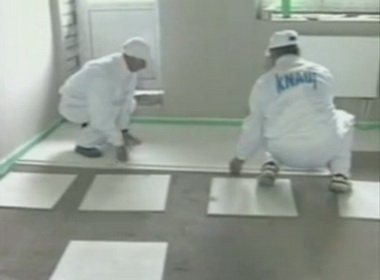

Cutting the material can be done with a jigsaw with a special file. And the fastening of individual panels to each other on the fold is done with PVA glue and screws, which are screwed in every 20 - 30 cm along the fold along its middle line.
There may be small gaps between the sheets. If the coating is not hard (carpet, linoleum), then all the gaps are putty.
If thin sheets of gypsum fiber board (10 mm) without folds are used to create floors, then they are laid in 2 - 3 layers. In this case, each layer is glued to the previous one. PVA glue is applied with a notched spatula to the laid bottom layer, and the top layer is always applied overlapping the seams with the bottom layer. Those. the middle of the top sheet should be where there is an intersection of the seams between the bottom sheets. Thus, a solid connected base is obtained, where elastic resistance to bending and fracture is provided by all layers at the same time, like a solid plate.


On elastic substrates made of insulation (dense foam, extruded polystyrene foam, mineral wool slabs for floors), thin sheets of gypsum fiber board should be laid in at least 3 layers under flexible floor coverings to achieve sufficient rigidity of the base.
As you can see, the work on laying a dry screed from gypsum fiber board can be done in the shortest possible time.For example, two workers can lay special folded sheets for the floor in one day on an area of up to 70 square meters, i.e. completely in a small house. It is also not difficult to make floors from gypsum fiber sheets with your own hands.
Sheet characteristics
In addition to hardness and strength, which is achieved due to the high concentration of the reinforcing element - cellulose, the material has a lot of other positive characteristics:
- Possibility of using in any kind of interior decoration - GVL plates are used for floor laying, installation of interior partitions, wall and ceiling cladding.
- Regulation of humidity - the structure of the material allows you to dry the room, absorbing excess moisture, and also "give" it back when the air becomes drier.
- High viscosity - the product is easy to install, does not crack or crumble during processing.
- Low thermal conductivity - the excellent thermal insulation properties of the material make it possible to use it as a reliable insulation material. This property is most in demand when using GVL sheets for flooring.
- Non-combustibility - gypsum fiber is used as fire protection for buildings and building structures. In the event of a fire, the material can prevent the spread of fire to adjacent rooms and restrict its access to important communications.
- Light weight - lightweight (about 18 kg) gypsum-fiber boards do not create a serious additional load on the load-bearing floors, their transportation and installation is not particularly difficult.
- The possibility of laying gypsum fiber board on a wooden floor or a concrete base - work on the installation of the floor covering is carried out in a fairly short time. Carpet, parquet, linoleum, laminate or tiles can be laid on the finished surface.
- Frost resistance - gypsum fiber boards withstand repeated freezing and thawing, which allows them to be used in cold unheated rooms: garages, garden or country houses.
Back to content ↑
Features of using GVL for the floor
Today, most craftsmen prefer the dry method of leveling the floor. Unlike a "wet" screed, this method avoids the following problems:
- the use of additional materials (concrete, sand, cement, gravel);
- the formation of a large amount of construction waste and dirt;
- time spent waiting for the cement mortar to dry.
It is not only easier to level the surface in this way, but also much faster - after laying the gypsum fiber board on the floor, you can immediately proceed to its final finishing.
Note that the use of modern materials for finishing floor cladding requires the arrangement of a reliable and absolutely flat base. Naturally, not all coatings can boast of excellent heat and sound insulation characteristics, so a screed made of gypsum fiber sheets will be the best option.
It should be added that for carpet, linoleum or laminate, these sheets can serve as a substrate.
Back to content ↑
Installation of gypsum fiber boards
Installation of GVL floors can be carried out on any basis - you just need to take into account some of the features of the laying technology. If increased requirements are imposed on the thermal insulation of the room, then the gypsum fiber will have to be reinforced with other materials, for example, expanded polystyrene plates.
It is necessary to carefully calculate the total thickness of the coating with additional insulation - this indicator can significantly affect the height of the room.
The structure of the gypsum fiber board allows you to mount the "warm floor" system on its surface. However, it should be remembered that the use of thick gypsum fiber board elements of the floor in this case is not recommended - ordinary sheets 10 mm thick are quite suitable.
Hidden laying of various engineering systems is another indisputable advantage of dry screed.
Back to content ↑
Preparation of the base
Before starting the installation activities, you should prepare the base by insulating it and installing guides. When leveling the floor in residential premises, expanded clay with a "caliber" of granules of no more than 50 mm can be used as a heater. Under the insulating layer, it is necessary to cover waterproofing - PET film, roofing felt or glassine.
Guides made of wooden beams, which need to be mounted on the surface of the base of floors made of gypsum fiber board, will perform two functions at once:
- a landmark that determines the level of insulation backfill;
- lathing for laying and fixing gypsum fiber boards.
After backfilling expanded clay, it must be leveled with the rule, relying on the guides, and carefully tamped, paying special attention to the corners of the room.


Back to content ↑
Installation process step by step
The process of installing a dry screed is a laborious and responsible event that should be carried out in several stages in a specific sequence:
- Along the wall near the floor, we lay a mounting tape that will absorb impact noise and compensate for deformations from stress and temperature fluctuations.
- We lay the first layer of gypsum fiber board for the floor, mounting the sheets from the corner closest to the entrance door to the room. We fix the slabs to the lathing using self-tapping screws of the required length.
- We apply an adhesive composition to the finished surface and mount the second layer of plates, laying them “in a run-up” position with an offset of 250–300 mm. For reliability, it can also be attached to the battens using longer screws.
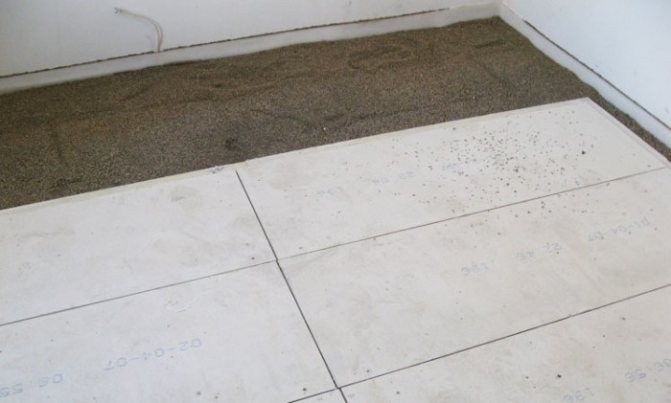

We have already talked about ready-made floor elements in the form of sheets, which are glued with an offset, forming folds for a more reliable connection. If you care about the strength of the floor and want to simplify its installation, then this is your choice. The only remark is that such material is somewhat more expensive than its standard counterparts.
Back to content ↑
